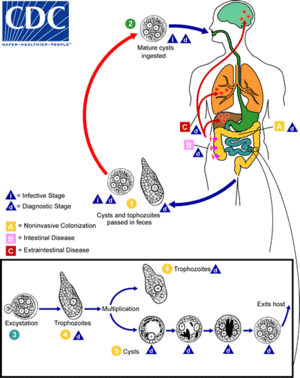Amoeba infections
| Amoebiasis | |
|---|---|
| Synonyms | Amoebic dysentery, amebiasis, entamoebiasis |
 |
|
| The life-cycle of various intestinal Entamoeba species | |
| Specialty | Infectious disease |
| Symptoms | Abdominal pain, diarrhoea, bloody diarrhea |
| Complications | Severe colitis, intestinal perforation, anemia |
| Causes | Amoebas of the Entamoeba group |
| Diagnostic method | Stool examination, antibodies in the blood |
| Differential diagnosis | Bacterial colitis |
| Prevention | Improved sanitation |
| Treatment |
Tissue disease: metronidazole, tinidazole, nitazoxanide, dehydroemetine, chloroquine, Intestinal infection: diloxanide furoate, iodoquinoline |
| Frequency | >480 million |
| Classification | |
|---|---|
| External resources |
Amoebiasis, also known amoebic dysentery, is an infection caused by any of the amoebas of the Entamoeba group. Symptoms are most common during infection by Entamoeba histolytica. Amoebiasis can be present with no, mild, or severe symptoms. Symptoms may include abdominal pain, diarrhea, or bloody diarrhea. Complications can include inflammation of the colon with tissue death or perforation, which may result in peritonitis. People affected may develop anemia due to loss of blood.
Cysts of Entamoeba can survive for up to a month in soil or for up to 45 minutes under fingernails. Invasion of the intestinal lining can cause bloody diarrhea. If the parasite reaches the bloodstream it can spread through the body, most frequently ending up in the liver where it can cause amoebic liver abscesses.Liver abscesses can occur without previous diarrhea. Diagnosis is typical by stool examination using a microscope, but may not reliably exclude infection or separate between specific types. An increased white blood cell count may be present in severe cases. The most accurate test is finding specific antibodies in the blood, but it may remain positive following treatment.Bacterial colitis can result in similar symptoms.
Prevention of amoebiasis is by improved sanitation, including separating food and water from faeces. There is no vaccine. There are two treatment options depending on the location of the infection. Amoebiasis in tissues is treated with either metronidazole, tinidazole, nitazoxanide, dehydroemetine or chloroquine, while luminal infection is treated with diloxanide furoate or iodoquinoline. Effective treatment against all stages of the disease may require a combination of medications. Infections without symptoms do not require treatment but infected individuals can spread the parasite to others and treatment can be considered. Treatment of other Entamoeba infections apart from E. histolytica is not needed.
...
Wikipedia
